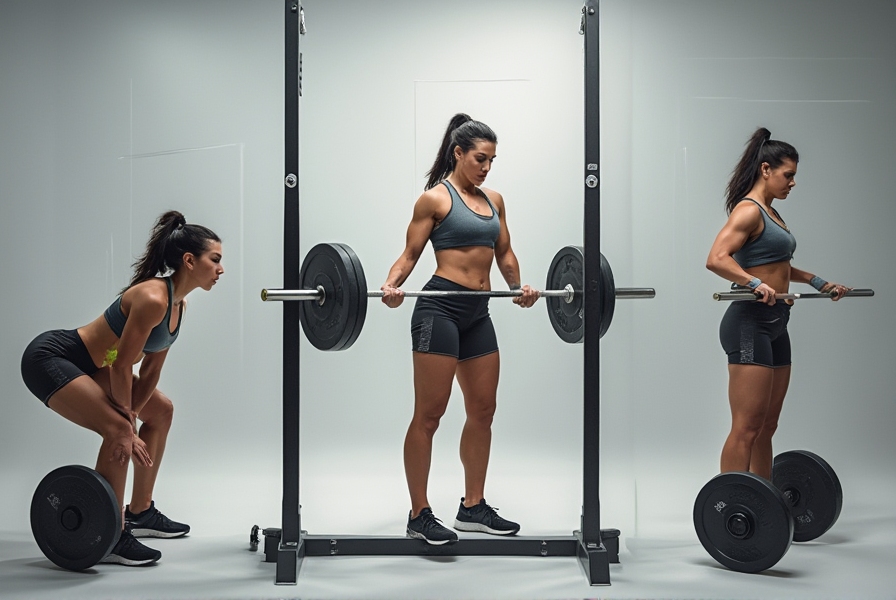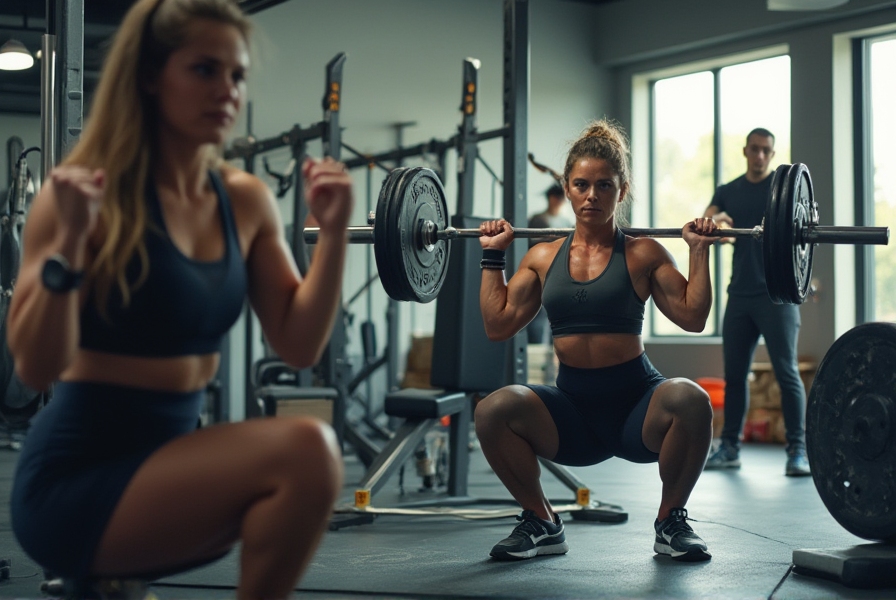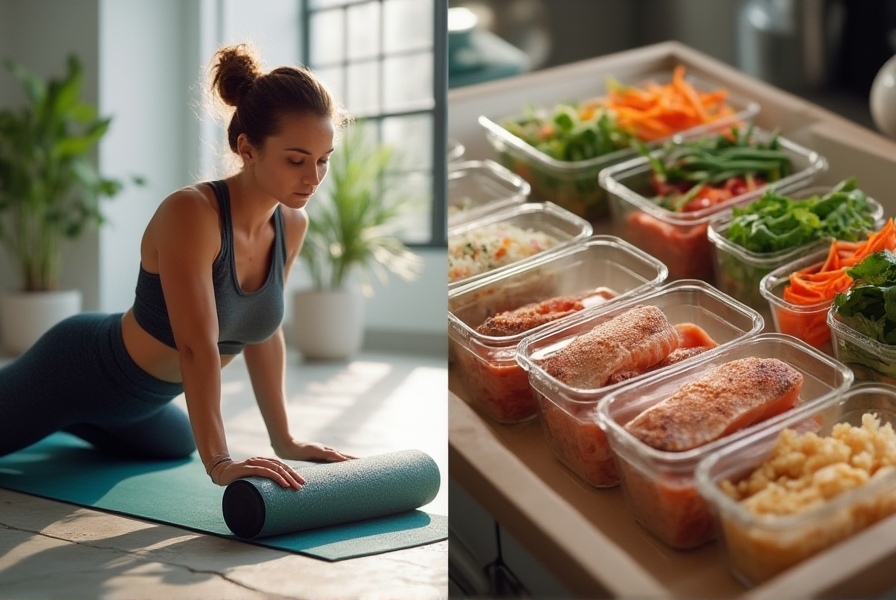I still remember my first day walking into a weight room. As a physiotherapist who spent long hours helping others move better, I felt completely lost when it came to my own strength journey. The barbells looked heavy, the racks seemed intimidating, and honestly, I had no idea where to start. Fast forward two years, and here I am, not just lifting weights I never thought possible, but also competing in powerlifting meets.
The numbers don’t lie – studies show that women who commit to regular strength training see a 20-40% increase in muscle strength within just 4 months. But these aren’t just statistics to me. I’ve watched countless women transform, both physically and mentally, as they discover their true strength.
If you’re reading this, you might be where I was – maybe standing all day at work, trying to figure out how to balance your career with a training schedule, or wondering if you’re doing the right things in the gym. You might have heard that women shouldn’t lift heavy, or that you’ll get “too bulky.” Let’s put those myths to rest right now.
This guide comes from both my clinical experience as a physiotherapist and my personal journey in powerlifting. We’ll cover:
- The real science behind women and strength training
- Step-by-step instructions for mastering key lifts
- How to build an effective training program that fits your life
- Smart recovery strategies (because yes, you can train hard even with a demanding job)
- Solutions to common challenges every woman faces under the bar
💪 Note: Whether you’re aiming to compete one day or simply want to feel stronger in your daily life, you’ll find actionable advice here. Ready to learn what your body is truly capable of?
Understanding the Fundamentals of Strength Training
Remember when I worried about “getting too bulky” from lifting? I laugh about that now. Here’s what actually happens in our bodies when we strength train: our muscles get stronger and more efficient, but due to our hormonal makeup, we don’t suddenly transform into bodybuilders. Women typically have about 1/15th to 1/20th the testosterone levels of men, which means building massive muscles isn’t something that happens by accident.
What does happen is pretty amazing though. Your body responds to strength training by:
- Building stronger bones (huge for preventing osteoporosis)
- Increasing your metabolic rate
- Improving connective tissue strength
- Enhancing nervous system efficiency
Here’s what the research shows specifically for women: Those who strength train 2-3 times per week see measurable improvements in bone density within 6 months. Plus, strength training helps maintain muscle mass as we age – we naturally lose about 3-8% per decade after age 30 without it.
Essential Equipment for Getting Started
Let’s talk about what you really need (and what you don’t). Basic equipment checklist:
Must-haves:
- A barbell and weights
- Squat rack with safety pins
- Flat bench
- Non-slip athletic shoes
Nice-to-haves:
- Lifting belt (for when you’re ready)
- Resistance bands for warm-ups
- Foam roller
- Microplates for small jumps in weight
Don’t waste money on fancy gadgets or supplements right away. Focus on the basics first.
Setting Realistic Goals and Expectations
After working with many women starting their strength journey, I’ve learned that setting the right expectations is key. Here’s a realistic progression timeline:
First 4-6 weeks:
- Focus on form and consistency
- Learn proper bracing
- Build workout habit
- Some strength gains from neural adaptation
Months 2-4:
- Start seeing measurable strength increases
- Better movement patterns
- Growing confidence with weights
- Improved recovery capacity
Months 4-6:
- Notable strength gains
- Better body awareness
- More consistent form
- Ready for structured programming
Remember: progress isn’t just about the numbers on the bar. Track things like:
- How clothes fit
- Energy levels
- Sleep quality
- Confidence in movements
- Recovery time
- Daily task ease
The Core Lifts: Proper Form and Technique
Let’s start with everyone’s favorite love-hate exercise. As someone who sees postural issues daily in my physio practice, I can tell you that learning to squat properly changes everything – from how you move at work to how you pick up heavy grocery bags.
Setup:
- Find your ideal foot position (usually shoulder-width)
- Position the bar across your upper back (not your neck!)
- Keep your chest proud and core tight
- Take a deep breath into your belly
Execution:
- Break at hips and knees together
- Keep knees in line with toes
- Maintain neutral spine
- Sink until hips are below knees
- Drive through your whole foot to stand
Common issues I see daily:
- Knees caving in? Often due to weak glutes – try band walks as warm-up
- Falling forward? Work on ankle mobility and core strength
- Can’t get deep enough? Start with box squats
- Back pain? Let’s check your bracing technique

The Deadlift: Your Best Friend for Full-Body Strength
The deadlift scared me most when I started. Now it’s my favorite lift. Here’s why you’ll love it too – it builds your posterior chain (back, glutes, hamstrings) like nothing else.
Setup essentials:
- Bar over mid-foot
- Feet hip-width apart
- Grip just outside your legs
- Hips higher than knees
- Chest up, shoulders back
The pull:
- Push the floor away
- Keep bar close to legs
- Squeeze glutes at top
- Control the descent
- Reset between reps
Watch out for:
- Rounding your back (biggest no-no)
- Starting with hips too low
- Letting bar drift forward
- Jerking the weight up
Bench Press: Not Just for the Boys
Ladies, the bench press isn’t just for show – it builds incredible upper body strength that carries over to everything from pushups to picking up kids.
Key points:
- Plant feet firmly
- Shoulder blades squeezed together
- Slight arch in lower back
- Eyes under bar
- Wrists straight
Movement pattern:
- Control bar down to chest
- Touch at nipple line
- Press up and slightly back
- Keep elbows under bar
- Maintain full-body tension
Programming Your Training for Success
After seeing hundreds of women start their strength journey, I’ve learned that the best program is one you’ll actually stick to. Here’s a proven approach that works around a busy life (like my packed schedule at the clinic):
Basic Weekly Framework:
- Day 1: Squat focus
- Day 2: Recovery/mobility
- Day 3: Bench focus
- Day 4: Rest
- Day 5: Deadlift focus
Here’s a sample day broken down:
| Component | Exercise Details |
|---|---|
| Warm-up | 10 mins mobility |
| Main lift | Squats 3×5 |
| Secondary | Romanian deadlifts 3×8 |
| Accessories | Split squats, planks |
| Cool down | 5 mins stretching |
Understanding Training Intensity
You don’t need to destroy yourself every session (learned that one the hard way). Here’s how to gauge intensity:
Rating of Perceived Exertion (RPE) Guide:
- RPE 6-7: Could do 4-5 more reps
- RPE 8: Could do 2 more solid reps
- RPE 9: Maybe 1 more rep
- RPE 10: Absolute max
For beginners, stick mostly to RPE 7-8. Save those RPE 9-10 sets for special occasions.

Balancing Volume and Recovery
Standing all day at work like I do? Here’s how to balance training with real life:
Volume Guidelines:
- 3-4 exercises per workout
- 2-4 sets per exercise
- 5-12 reps per set
- Rest 2-3 minutes between sets
Recovery Markers:
- Sleep quality
- Morning energy
- Muscle soreness
- Motivation levels
- Movement quality
⭐ Pro Tip: From my physio background: Your body adapts during recovery, not during training. If you’re consistently dragging through workouts, you need more rest, not more sets.
Signs You Need More Recovery:
- Persistent fatigue
- Declining performance
- Poor sleep
- Irritability
- Nagging joint pain
Recovery and Nutrition Fundamentals
Nutrition to Support Strength Training
Let me share what works in real life – not just theory. When you’re juggling client appointments and training sessions like I do, your nutrition needs to be practical.
Protein Basics:
- Aim for 1.6-2.0g per kg bodyweight
- Space it throughout the day
- Include some at every meal
- Focus on whole food sources first
Sample Meal Timing:
| Timing | Nutrition Requirements |
|---|---|
| Pre-workout (1-2 hours before) |
• Medium-sized meal with carbs • Moderate protein • Low fat • Easy to digest |
| Post-workout (within 2 hours) |
• Protein source • Quick-digesting carbs • Plenty of water |
Recovery Strategies for Busy Women
Real talk – between work, training, and life, recovery needs to be simple and effective.
Sleep Priorities:
- 7-9 hours nightly
- Consistent bedtime
- Dark, cool room
- No screens 30 mins before bed
Quick Recovery Methods:
- 10-min morning mobility
- Light walking between clients
- Basic stretching before bed
- Foam rolling while watching TV

Managing Soreness and Preventing Injury
As a physiotherapist who lifts, here’s what I tell my clients (and follow myself):
Good Pain vs Bad Pain:
- Good: General muscle soreness
- Good: Temporary fatigue
- Bad: Sharp or shooting pain
- Bad: Pain that worsens during warmup
Smart Warm-up Strategy:
- 5 mins light cardio
- Dynamic stretches
- Movement pattern practice
- Gradual weight increases
Red Flags to Watch:
- Sharp joint pain
- Numbness/tingling
- Decreased range of motion
- Pain that lasts >1 week
When to see a professional:
- Pain changes your technique
- Symptoms don’t improve
- Loss of strength
- Unusual swelling
Common Challenges and Solutions
Time Management Strategies
Real talk from someone who works 9-hour days: finding time to train isn’t about having time – it’s about making time. Here’s what works:
Efficient Training Tips:
- Pack gym bag night before
- Prep meals in batches
- Supersets when time-crunched
- 45-60 min focused sessions
| Exercise Block | Sets |
|---|---|
| A. Main lift | 3-4 working sets |
| B1. Accessory 1 | 3 sets |
| B2. Accessory 2 | 3 sets |
| C. Core work | 2-3 sets |
Plateau Breaking
Hit a wall? Been there! Here’s what I learned after my first competition plateau:
Signs of a True Plateau:
- No progress for 3+ weeks
- Form stays good
- Sleep and nutrition on point
- Recovery adequate
Breaking Through:
- Check your form first
- Vary rep ranges
- Add pause variations
- Consider a deload week
Building Confidence Under the Bar
Remember my first time walking into the weight room? Here’s what helped me (and now helps my clients):
Confidence Builders:
- Film your lifts
- Track your progress
- Celebrate small wins
- Connect with other lifters
Dealing with Gym Anxiety:
- Go during quieter hours
- Have a plan written down
- Start with basics
- Focus on your workout
Finding Your Community:
- Local lifting groups
- Online forums
- Social media connections
- Gym buddies
⭐ Pro Tip: Every single strong woman you see at the gym started somewhere. Most are happy to help if you ask!
Your Strength Journey Starts Here
Let me share something personal – the day I first squatted my bodyweight, I cried. Not from pain, but because I never thought I’d be that strong. Every woman I’ve trained has a moment like this – when they realize they’re capable of so much more than they imagined.
Remember:
- Start where you are
- Progress at your pace
- Trust the process
- Keep showing up
Here’s your first-step action plan:
- Pick 3 days this week to train
- Practice the main lifts with light weights
- Focus on form above everything
- Track your starting weights
- Take progress photos (trust me on this)
I’m here to tell you – as both a physiotherapist and a woman who lifts – that strength training will change your life. Not just your body, but your confidence, your capabilities, and your entire outlook.
Book a free strength training session with me. Let’s make sure you’re starting with solid technique and a program that fits your life. I’ll help you avoid the mistakes I made when I started.
Ready to discover your strength? Schedule your session or drop me a message at admin@pulseplayground.com or call with your questions at 0491 970 713. Your future self will thank you for starting today.



